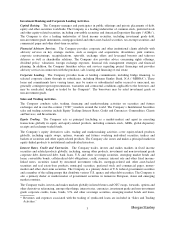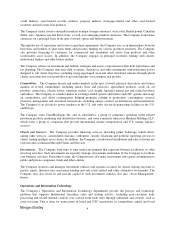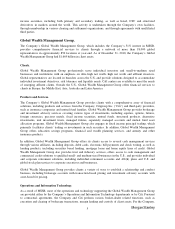Morgan Stanley 2010 Annual Report Download - page 19
Download and view the complete annual report
Please find page 19 of the 2010 Morgan Stanley annual report below. You can navigate through the pages in the report by either clicking on the pages listed below, or by using the keyword search tool below to find specific information within the annual report.
See also “Management’s Discussion and Analysis of Financial Condition and Results of Operation—Liquidity
and Capital Resources—Regulatory Requirements” in Part II, Item 7 herein.
Orderly Liquidation Authority. Under the Dodd-Frank Act, financial companies, including bank holding
companies such as Morgan Stanley and certain covered subsidiaries, can be subjected to a new orderly
liquidation authority. The U.S. Treasury must first make certain extraordinary financial distress and systemic risk
determinations. Absent such U.S. Treasury determinations, Morgan Stanley as a bank holding company would
remain subject to the U.S. Bankruptcy Code.
The orderly liquidation authority went into effect in July 2010, but rulemaking is required to render it fully
operative. If the Company were subjected to the orderly liquidation authority, the FDIC would be appointed
receiver, which would give the FDIC considerable rights and powers that it must exercise with the goal of
liquidating and winding up the Company, including (i) the FDIC’s right to assign assets and liabilities and
transfer some to a third party or bridge financial company without the need for creditor consent or prior court
review; (ii) the ability of the FDIC to differentiate among creditors in exercising its cherry-picking powers,
including by treating junior creditors better than senior creditors, subject to a minimum recovery right to receive
at least what they would have received in bankruptcy liquidation; and (iii) the broad powers given the FDIC to
administer the claims process to determine which creditor receives what, and in which order, from assets not
transferred to a third party or bridge financial institution.
The FDIC can provide a broad range of financial assistance for the resolution process, and, if it does so, it must
ensure that unsecured creditors bear losses up to the amount they would have suffered in liquidation (or as
otherwise determined by the FDIC), and that management or board members of the financial company
responsible for the failed condition are removed. Amounts owed to the U.S. are generally given priority over
claims of general creditors. In addition, to the extent the FDIC funds the liquidation of a financial company with
borrowings from the U.S. Treasury, it is authorized to assess claimants that receive benefits in excess of their
claims in a bankruptcy liquidation, as well as systemically important or other large financial institutions, to repay
such borrowings.
A number of creditor rights in the orderly liquidation authority have been modeled after the Bankruptcy Code,
and the FDIC must promulgate implementing regulation in a manner that further reduces the gap in treatment
between the two regimes and increases legal certainty. However, the orderly resolution authority is untested and
differs in material respects from the Bankruptcy Code, including in the broad powers granted to the FDIC as
receiver. As a result, the Company cannot exclude the possibility that shareholders, creditors and other
counterparties of the Company and similarly situated financial companies will reassess the credit risk posed by
the possibility that the Company could be subjected to the orderly liquidation authority, and could seek to be
compensated for any perceived risk of greater credit losses in such event.
In addition to the orderly liquidation authority, the Dodd-Frank Act also eliminates some of the regulatory
authorities used in the recent financial crisis to intervene and support individual financial institutions. As a result
of these developments, credit rating agencies have announced that they would review financial institutions’
ratings to potentially adjust the previously assumed level of government support as a factor in their ratings. These
developments may have potential negative implications for such institutions’ ratings to the extent the credit
rating agencies’ assessment of the impact of systemic risk regulation on the assumed level of government support
negatively influences the Company’s credit ratings, that in turn could negatively impact the Company’s funding
costs. See also “Management’s Discussion and Analysis of Financial Condition and Results of Operation—
Liquidity and Capital Resources—Credit Ratings” in Part II, Item 7 herein.
Dividends. In addition to certain dividend restrictions that apply by law to certain of the Company’s
subsidiaries, as described below, the OCC, the Federal Reserve and the FDIC have authority to prohibit or to
limit the payment of dividends by the banking organizations they supervise, including the Company, MSBNA
and other depository institution subsidiaries of the Company, if, in the banking regulator’s opinion, payment of a
dividend would constitute an unsafe or unsound practice in light of the financial condition of the banking
13
























